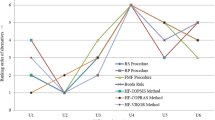Abstract
Multi-objective linear programming (MOLP) multi-criterion decision-making problem has been solved first by using a LP modeller—PuLP written in Python and then solved it by LP method to set goal for each objective. Again, the MOLP problem has been solved in fuzzy environment to check the accuracy of most possible clarification of the goals. Here, in the proposed FLP model format, comparative weights close to the fuzzy operative term represent the relative worth of the objective functions and help to achieve the better goal. Furthermore, the projected activity based on E-learning technique is simply to be valid in that time when real world faces existent living problems (disaster/pandemic), which give improved result in the common sense that the values of objectives are adequately nearer to their goals. At last, one real model is used to exhibit the accuracy and utility of the projected process.
Access this chapter
Tax calculation will be finalised at checkout
Purchases are for personal use only
Similar content being viewed by others
References
Blank, J., Deb, K.: Pymoo: multi-objective optimization in python. IEEE Access 8, 89497–89509 (2020). https://doi.org/10.1109/ACCESS.2020.2990567
Dong, J., Wan, S.: A new method for solving fuzzy multi-objective linear programming problems. Iran. J. Fuzzy Syst. 16(3), 145–159 (2019). https://doi.org/10.22111/ijfs.2019.4651
Azadeh, A., et al.: A multi-objective fuzzy linear programming model for optimization of natural gas supply chain through a greenhouse gas reduction approach. J. Nat. Gas Sci. Eng. 26, 702–710 (2015). https://doi.org/10.1016/j.jngse.2015.05.039
Andrade, R., Doostmohammadi, M., Santos, J.L., et al.: MOMO—multi-objective metabolic mixed integer optimization: application to yeast strain engineering. BMC Bioinform. 21, 69 (2020). https://doi.org/10.1186/s12859-020-3377-1
Zadeh, L.A.: Fuzzy sets. Inf. Comput. 8, 338–353 (1965)
Tanaka, H., Okuda, T., Asai, K.: On fuzzy-mathematical programming. J. Cybern. 3(4), 37–46 (1973)
Author information
Authors and Affiliations
Editor information
Editors and Affiliations
Rights and permissions
Copyright information
© 2022 The Author(s), under exclusive license to Springer Nature Singapore Pte Ltd.
About this paper
Cite this paper
Sengupta, I., Mishra, B.S.P., Mallick, P.K. (2022). Proposed Multi-criterion Decision-Making Model—On Online Education System Perspective. In: Dehuri, S., Prasad Mishra, B.S., Mallick, P.K., Cho, SB. (eds) Biologically Inspired Techniques in Many Criteria Decision Making. Smart Innovation, Systems and Technologies, vol 271. Springer, Singapore. https://doi.org/10.1007/978-981-16-8739-6_43
Download citation
DOI: https://doi.org/10.1007/978-981-16-8739-6_43
Published:
Publisher Name: Springer, Singapore
Print ISBN: 978-981-16-8738-9
Online ISBN: 978-981-16-8739-6
eBook Packages: Intelligent Technologies and RoboticsIntelligent Technologies and Robotics (R0)




